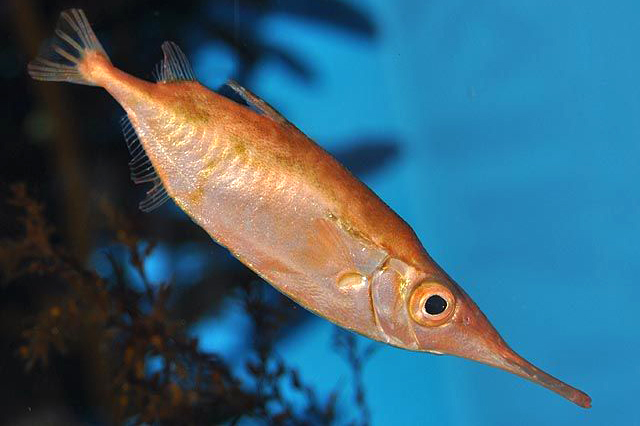Little Bellowsfish, Macroramphosus gracilis (Lowe 1839)

A Little Bellowsfish, Macroramphosus gracilis, in the Aquarium of the Pacific. Source: Ross D. Robertson / Shorefishes of the neotropics. License: CC by Attribution-Noncommercial
Little Bellowsfish are slender marine fishes with a laterally compressed body, a tiny mouth at the end of a long tubular snout, and a long, robust second dorsal-fin spine.
Little Bellowsfish, Macroramphosus gracilis (Lowe 1839)
More Info
|
Distribution |
Widespread in the Indo-Pacific, known from the Eastern Central Pacific and Western Central Atlantic oceans, including in the Mediterranean Sea. In Australian waters, the Little Bellowsfish is known from off eastern Australia, including the area around Lord Howe Island. They are benthic or benthopelagic on the continental shelf and slope at 100-1000m, and have not been recorded from the south coast of Australia. |
|
Features |
Meristic featuress: Dorsal fin IV–VII, 10–13; Anal fin 18–19; Vertebrae 23–24; Branchiostegal rays 4. Body, elongate, relatively slender; 2nd dorsal-fin spine relatively short; posterior margin of second dorsal-fin spine smooth in specimens larger than 50 mm SL. |
|
Size |
To 15 cm TL |
|
Feeding |
Feed primarily on planktonic copepods, also feed on decapods and pteropods. |
|
Biology |
The sexes are separate and fertilisation is external. The eggs and larvae are pelagic. Larvae are found in surface waters and have a straight ventral body profile. Juveniles are darkly pigmented, have a straight ventral body profile, and are found in surface waters until about 40mm SL. |
|
Fisheries |
Little Bellowsfish are often taken as bycatch in commercial fisheries. |
|
Conservation |
Not evaluated. |
|
Remarks |
In the past, some authors considered the genus Macroramphosus to be monotypic, and that all small specimens were juveniles of M. scolopax. |
|
Similar Species |
Macroramphosus gracilis differes from M. scolopax in having the first dorsal fin originating before the anus, and the second spine of first dorsal-fin does not extend beyond the second dorsal-fin base. The distance between the first and second drosal fins is greater than the eye diameter. |
|
Etymology |
Macroramphosus is from the Greek, makros, meaning great, and rhamphos, meaning beak or bill, in reference to the long tubular snout. The species name gracilis, is Latin meaning slender or thin, in reference to the relatively slender body of the Little Bellowsfish. |
|
Species Citation |
Centriscus gracilis Lowe 1839: Proc. Zool. Soc. Lond. 7: 86, Madeira. |
|
Author |
Dianne J. Bray & Vanessa J. thompson |
Little Bellowsfish, Macroramphosus gracilis (Lowe 1839)
References
Assis, CA. 1992. On the systematics of Macrorhamphosus scolopax (Linnaeus, 1758) and Macrorhamphosus gracilis (Lowe, 1839). A preliminary biometrical approach. Bol Soc Port Cienc Nat (2nd Sér.) 25: 5–19.
Bilecenoglu, M. 2006. Status of the genus Macroramphosus (Syngnathiformes: Centriscidae) in the eastern Mediterranean Sea. Zootaxa 1273: 55–64.
Clarke, T.A. 1984. Diet and morphological variation in snipefishes, presently recognized as Macrorhamphosus scolopax, from southeast Australia: Evidence for two sexually dimorphic species. Copeia 1984(3): 595-608.
Ehrich, S. 1986. Macroramphosidae. In: Whitehead P, Bauchot M, Hureau J, Nielsen J, Tortonese E (eds) Fishes of the northeastern Atlantic and the Mediterranean (FNAM), vol 2. UNESCO, Paris, p 627
Gomon, M.F. 2008. Family Macrorhamphosidae (p. 480-484). In Gomon, M.F., D.J. Bray & R.H. Kuiter. (eds.) Fishes of Australia's Southern Coast. Reed New Holland, Chatswood, Australia, 928 pp.
Heemstra P.C. 1986 Macroramphosidae in Smith M.M. and Heemstra P.C. (eds) Smiths’ Sea Fishes. Macmillian South Africa Pty Ltd.
Kuiter, R. H. 2009. Seahorses and their relatives. Aquatic Photographics, Seaford, Australia. 333 pp.
Matthiessen, B., Fock, H, & H. von Westernhagen. 2003. Evidence for two sympatric species of snipefishes Macroramphosus spp. (Syngnathiformes, Centriscidae) on Great Meteor Seamount. Helgol Mar Res 57: 63–72.
Miyazaki, E., Sasaki, K., Mitani T., Ishida, M. & Uehara, S. 2004. The occurrence of two species of Macroramphosus (Gasterosteiformes: Macroramphosidae) in Japan: morphological and ecological observations on larvae, juveniles and adults. Ichthyological Research 51: 256-262.
Nelson, J.S. 2006. Fishes of the world. 4th edn. John Wiley & Sons, New Jersey, 601 p.
Oliveira, R.F., Almada, V.C., Gil, M.F. 1993. The reproductive behavior of the longspine snipefish Macrorhamphosus scolopax (Syngnathiformes, Macrorhamphosidae). Environ Biol Fishes 36: 337–343.
Paxton, J.R., J.E. Gates & D.F. Hoese. 2006. Gasterosteiformes, In Beesley, P.L. & A. Wells (Eds). Zoological catalogue of Australia. Volume 35 Fishes. ABRS & CSIRO Publishing, Australia. Part 2.
Robalo, J.I., C.Sousa-Santos, H. Cabral, R. Castilho & V.C. Almada. 2009. Genetic evidence fails to discriminate between Macroramphosus gracilis Lowe 1839 and Macroramphosus scolopax Linnaeus 1758 in Portuguese waters. Mar. Biol. 156: 1733–1737.


